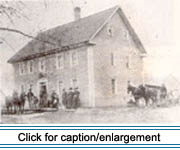|
 According
to family tradition, the Val Violette house has stood on its present site
in Van Buren since 1850 when it was built on River Lot 301. It is believed
that the house contains parts of an older residence that was moved from
a location closer to the St. John River. The house has been passed from
father to son over four generations. The male lineage of the Violette
family originates in Angoumois, France, and traces family movement to
Saintes, France; Louisbourg, Cape Breton Island, Nova Scotia; then to
the St. John Valley. It is currently the residence of Val and Anne Violette. According
to family tradition, the Val Violette house has stood on its present site
in Van Buren since 1850 when it was built on River Lot 301. It is believed
that the house contains parts of an older residence that was moved from
a location closer to the St. John River. The house has been passed from
father to son over four generations. The male lineage of the Violette
family originates in Angoumois, France, and traces family movement to
Saintes, France; Louisbourg, Cape Breton Island, Nova Scotia; then to
the St. John Valley. It is currently the residence of Val and Anne Violette.
Belonie Violette (1817ñ1879), builder of the Val Violette House, was
a third-generation owner of what in the American era became Lot 301 in
Township M, Range 2. In 1831, when both Maine and New Brunswick claimed
the territory, Maine agents John G. Deane and Edward Kavanagh were sent
north to determine the demographics of the disputed area. When they interviewed
 Belonie Violetteîs father, FranÁois Violette (1770ñ1856), he told them
that his father, FranÁois Violette, Sr. (1744ñ1824), built a gristmill
on the site "forty years ago." He also told them that he had taken up
residence there "three years ago." He explained that his family owned
a larger estate, some 90 rods in width, at the mouth of Grande-RiviÉre,
in what is now Saint-Léonard, New Brunswick. And he noted his familyîs
receipt of a British grant to that site in 1826.
Belonie Violetteîs father, FranÁois Violette (1770ñ1856), he told them
that his father, FranÁois Violette, Sr. (1744ñ1824), built a gristmill
on the site "forty years ago." He also told them that he had taken up
residence there "three years ago." He explained that his family owned
a larger estate, some 90 rods in width, at the mouth of Grande-RiviÉre,
in what is now Saint-Léonard, New Brunswick. And he noted his familyîs
receipt of a British grant to that site in 1826.
Shortly after acquiring title from his father, Belonie Violette sold
the propertyîs gristmill privilege to Vital Thibodeau of Saint-Basile
who would further develop it. In 1846 he deeded the first of two sawmill
sites. Realizing the potential of Violette Stream, which flowed from Violette
Pond, Belonie Violette sold the site of a second sawmill in 1855 to George
W. Smith and Charles Crosby of Bangor, Maine. Later, Smith and Crosby
drove cedar logs downstream to the mill site and manufactured shingles, the
first to be sent out of the Upper St. John Valley area to American markets.
In 1860, Smith and Crosby sold their mill to W. C. Hammond, whose family
had been associated with the lumber industry in New Brunswick.
|
 |
 |
Apparently Belonie Violette preferred not to become involved in lumber
milling, which was considered a risky business. Instead, he farmed Lot
301 and sold land. In addition, he maintained an interest in civic affairs.
He was elected to the Board of Assessors of Van Buren Plantation in 1844,
served as one of three Aroostook County Commissioners in 1856, and in
1866 he was elected to a term in the Maine State legislature.
Belonie Violetteîs family grew to fourteen children, seven boys and seven
girls. Instead of diminishing the value of the homesite by parceling it
among his children in equal shares, Violette bought farms in newly developed
sectors of the plantation, and turned them over to his sons when they
attained maturity. Thus the eldest son, Frederic, would have a farm in
Cyr Plantation and the next son, Dennis, raised his family in nearby Hamlin.
 In
1875, Violette consigned the family estate to his spouse on the understanding
that whenever she decided to become a pensioner of an inheriting son,
that son would provide for his younger siblings in the manner that the
elder sons had been provided for. Therefore, when the middle son, Ambroise
(1850ñ1911), agreed to take his mother as pensioner after Belonieîs death
four years later, he also agreed to provide dowries for his unmarried
younger sisters and to provide his younger brothers with farms of their
own. Until they attained maturity, the younger brothers were bound to
work for their supporting brother and mother on the original homestead. In
1875, Violette consigned the family estate to his spouse on the understanding
that whenever she decided to become a pensioner of an inheriting son,
that son would provide for his younger siblings in the manner that the
elder sons had been provided for. Therefore, when the middle son, Ambroise
(1850ñ1911), agreed to take his mother as pensioner after Belonieîs death
four years later, he also agreed to provide dowries for his unmarried
younger sisters and to provide his younger brothers with farms of their
own. Until they attained maturity, the younger brothers were bound to
work for their supporting brother and mother on the original homestead.
|
|

